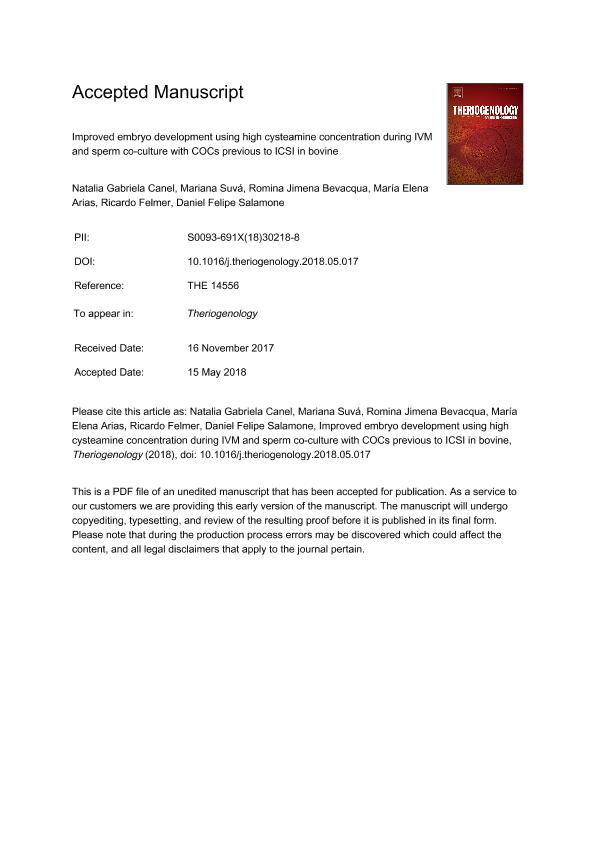Mostrar el registro sencillo del ítem
dc.contributor.author
Canel, Natalia Gabriela

dc.contributor.author
Suvá, Mariana

dc.contributor.author
Bevacqua, Romina Jimena

dc.contributor.author
Arias, María Elena
dc.contributor.author
Felmer Dörner, Ricardo Nicolás

dc.contributor.author
Salamone, Daniel Felipe

dc.date.available
2019-12-04T17:57:58Z
dc.date.issued
2018-09
dc.identifier.citation
Canel, Natalia Gabriela; Suvá, Mariana; Bevacqua, Romina Jimena; Arias, María Elena; Felmer Dörner, Ricardo Nicolás; et al.; Improved embryo development using high cysteamine concentration during IVM and sperm co-culture with COCs previous to ICSI in bovine; Elsevier Science Inc; Theriogenology; 117; 9-2018; 26-33
dc.identifier.issn
0093-691X
dc.identifier.uri
http://hdl.handle.net/11336/91372
dc.description.abstract
In contrast to other species, intracytoplasmic sperm injection (ICSI) in bovine remains inefficient, resulting in low embryo developmental rates. It is unclear whether such inefficiency is due to the poor response of bovine ooplasms to the injection stimulus, or to the inability of bull sperm to induce oocyte activation. In order to facilitate these events, two strategies were assessed: the use of high concentration of cysteamine [Cys] during IVM; and the selection of sperm attached to cumulus cells after incubation with COCs for ICSI. First, COCs were IVM with increasing [Cys] and subjected to IVF. Zygotes from all groups were cultured under different O2 tensions and development to blastocyst was evaluated. In a second experiment, sperm were co-cultured for 3 h with COCs and acrosome reaction was studied. Afterwards, the best IVM and IVC conditions determined on Experiment 1 were used for ICSI assay. COCs were matured for 21 h with 1 (Cys 1) or 0.1 mM Cys (Cys 0.1 groups, standard condition). In addition, COCs were incubated for ≥3 h with 16 × 106 sperm/ml and only sperm attached to cumulus cells were selected for ICSI (ICSI + Co-cult groups). After chemical activation, embryos were cultured in SOF medium under low O2 tension. Cleavage and blastocyst rates were evaluated at days 2 and 7 of IVC, respectively. Finally, the relative expression of eight genes indicators of embryo quality was compared between ICSI and IVF control blastocysts by qPCR. Cleavage rates were higher for Cys 0.1 ICSI + Co-cult and Cys 1 ICSI + Co-cult groups (n = 117, 92% and n = 116, 79%, respectively) compared to their controls (n = 132, 60% for Cys 0.1 ICSI and n = 108, 52% for Cys 1 ICSI) (p ≤ 0.05). Interestingly, the combined treatment (Cys 1 ICSI + Co-cult) showed higher blastocyst rates than all other ICSI groups (23 vs. 11, 18 and 14% for Cys 0.1 ICSI + Co-cult, Cys 1 ICSI, and Cys 0.1 ICSI, respectively) (p ≤ 0.05). Moreover, incubation with COCs increased the rates of live acrosome reacted sperm (p ≤ 0.05). The relative abundance of mRNAs coding for INFτ CAT, DNMT1, OCT4, and HDAC3 did not differ between treatments (p ≤ 0.05). SOD2, HADC1 and HADC2 expression was higher for Cys 0.1 ICSI than for IVF embryos (p ≤ 0.05). Group Cys 1 ICSI did not differ from IVF for those three genes, neither did Cys 1 ICSI + Co-cult, except for HDAC1 (p ≤ 0.05). In conclusion, the use of 1 mM Cys during IVM and of sperm incubated with mature COCs might be a good strategy to improve ICSI outcomes in cattle.
dc.format
application/pdf
dc.language.iso
eng
dc.publisher
Elsevier Science Inc

dc.rights
info:eu-repo/semantics/openAccess
dc.rights.uri
https://creativecommons.org/licenses/by-nc-nd/2.5/ar/
dc.subject
CUMULUS CELLS
dc.subject
GENE EXPRESSION
dc.subject
IN VITRO MATURATION
dc.subject
OXYGEN TENSION
dc.subject
PRETREATMENT
dc.subject
SPERM INJECTION
dc.subject.classification
Tecnología GM, clonación de ganado, selección asistida, diagnósticos, tecnología de producción de biomasa, etc.

dc.subject.classification
Biotecnología Agropecuaria

dc.subject.classification
CIENCIAS AGRÍCOLAS

dc.title
Improved embryo development using high cysteamine concentration during IVM and sperm co-culture with COCs previous to ICSI in bovine
dc.type
info:eu-repo/semantics/article
dc.type
info:ar-repo/semantics/artículo
dc.type
info:eu-repo/semantics/publishedVersion
dc.date.updated
2019-10-18T19:07:31Z
dc.journal.volume
117
dc.journal.pagination
26-33
dc.journal.pais
Estados Unidos

dc.description.fil
Fil: Canel, Natalia Gabriela. Consejo Nacional de Investigaciones Científicas y Técnicas. Oficina de Coordinación Administrativa Parque Centenario. Unidad Ejecutora de Investigaciones en Producción Animal. Universidad de Buenos Aires. Facultad de Ciencias Veterinarias. Unidad Ejecutora de Investigaciones en Producción Animal; Argentina
dc.description.fil
Fil: Suvá, Mariana. Consejo Nacional de Investigaciones Científicas y Técnicas. Oficina de Coordinación Administrativa Parque Centenario. Unidad Ejecutora de Investigaciones en Producción Animal. Universidad de Buenos Aires. Facultad de Ciencias Veterinarias. Unidad Ejecutora de Investigaciones en Producción Animal; Argentina
dc.description.fil
Fil: Bevacqua, Romina Jimena. Consejo Nacional de Investigaciones Científicas y Técnicas. Oficina de Coordinación Administrativa Parque Centenario. Unidad Ejecutora de Investigaciones en Producción Animal. Universidad de Buenos Aires. Facultad de Ciencias Veterinarias. Unidad Ejecutora de Investigaciones en Producción Animal; Argentina
dc.description.fil
Fil: Arias, María Elena. Universidad de La Frontera; Chile
dc.description.fil
Fil: Felmer Dörner, Ricardo Nicolás. Universidad de La Frontera; Chile
dc.description.fil
Fil: Salamone, Daniel Felipe. Consejo Nacional de Investigaciones Científicas y Técnicas. Oficina de Coordinación Administrativa Parque Centenario. Unidad Ejecutora de Investigaciones en Producción Animal. Universidad de Buenos Aires. Facultad de Ciencias Veterinarias. Unidad Ejecutora de Investigaciones en Producción Animal; Argentina
dc.journal.title
Theriogenology

dc.relation.alternativeid
info:eu-repo/semantics/altIdentifier/doi/http://dx.doi.org/10.1016/j.theriogenology.2018.05.017
dc.relation.alternativeid
info:eu-repo/semantics/altIdentifier/url/https://www.sciencedirect.com/science/article/pii/S0093691X18302188
Archivos asociados
